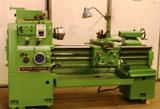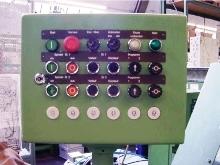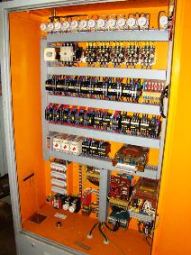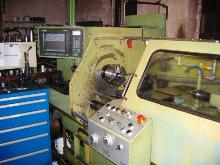Precautions when servicing electrical equipment of metal cutting machines
 Modern machines, as a rule, have an individual electric drive. In most cases, electric motors, relays and other electrical devices are located either on the machine itself or in an autonomous closet. Machines have motors, limit switches and limit switches located inside the machine.
Modern machines, as a rule, have an individual electric drive. In most cases, electric motors, relays and other electrical devices are located either on the machine itself or in an autonomous closet. Machines have motors, limit switches and limit switches located inside the machine.
The work of setting up, operating and repairing electrical equipment of metal cutting machines is divided into four categories: work with complete disposal, work with partial shutdown, work without shutdown near busbars, and work without shutdown from busbars.
Work with full stress relief is considered to be carried out in an electrical installation where the voltage is removed from all live parts and where there is no unlocked entrance to an adjacent live electrical installation.
This type of work includes:
a) continuity of power circuit circuits,
b) repair or replacement of electrical equipment directly on the machine,
c) checking the insulation resistance value of live parts.
Work with partial stress relief is considered when work is carried out on disconnected parts of an electrical installation while other parts of it are energized or the voltage is completely removed, but there is an unlocked entrance to an adjacent live electrical installation.
This type of work includes:
a) adjustment of relay activation parameters,
b) adjustment and cleaning of device contacts,
c) changing the lighting lamps in the cabinet and on the machine.
Work without de-energizing near and on live parts work that requires the adoption of technical and organizational measures and is carried out on a switched-off electrical installation with the help of safety devices. This type of work includes: measuring current and voltage values using measuring clamps.
 Work without de-energizing away from live parts is considered work in which the accidental approach of working people and the repair equipment and tools used by them to currents of parts at a dangerous distance is excluded and technical and organizational measures are not required to prevent of such an approach.
Work without de-energizing away from live parts is considered work in which the accidental approach of working people and the repair equipment and tools used by them to currents of parts at a dangerous distance is excluded and technical and organizational measures are not required to prevent of such an approach.
This type of work includes:
a) wiping the control panels and control cabinets from the outside,
b) wiping the electric motors of the machine,
c) measurement of engine revolutions with a tachometer,
The work on the adjustment of the electrical equipment of the machines must be carried out by at least two persons, the largest of whom - the manufacturer of the work - must have a qualification group of at least the third, and the second - a member of the brigade - not lower than the second.
Commissioning carried out by verbal or written order of the responsible head of work (head of the electrical laboratory, mechanic, operator or senior electrician), who checks whether the manufacturer has a certificate for the right to work with electrical equipment, gives an adjustment task and provides him with a technical documentation (electric circuit diagram and its specification).
Immediately before the acceptance of the brigade at work admission (duty electrician or responsible work manager) checks:
a) the members of the brigade have certificates for the right to work,
b) knowledge of the manufacturer about the operation of the "Rules of technical operation of electrical installations of consumers «,» Safety rules for operation of electrical installations of consumers «and electrical diagram of configurable equipment,
c) ensuring the safe production of work at the workplace.
 Before starting work, the contractor prepares the workplace: the switch remote control device of the machine is set to the "Disabled" position and displays a poster "Do not include - people work", examines the technical condition of the control panel, the cabinet with electrical equipment: prepares protective equipment , mats, dielectric gloves, installation tool), prepares electrical measuring and other devices necessary for adjustment.
Before starting work, the contractor prepares the workplace: the switch remote control device of the machine is set to the "Disabled" position and displays a poster "Do not include - people work", examines the technical condition of the control panel, the cabinet with electrical equipment: prepares protective equipment , mats, dielectric gloves, installation tool), prepares electrical measuring and other devices necessary for adjustment.
After carrying out preparatory work, the manufacturer allows the team to start work. During the adjustment of the electrical equipment, the team is allowed to perform the following work:
a) checking the correctness of the installation,
b) turning on and off the equipment,
c) manipulation of the controls (buttons, keys, command devices) of the machine and the control panel,
d) identification of equipment defects through inspection,
e) replacement of defective places of installation of secondary switching and power circuit,
f) replacement of defective equipment,
g) measurement of circuit parameters with portable measuring instruments,
h) testing the electrical equipment of the machine with increased voltage,
i) measuring the insulation resistance of apparatus coils and windings of electrical machines with a megohmmeter,
j) testing the electrical equipment of the machine at idle and under load.
Checking for defects in the electrical circuit can only be carried out with the equipment completely switched off. The inspection of electrical equipment in order to identify its defects can be carried out without removing the voltage from the manufacturer at work through an open door in the presence of a second person from the team.
Replacement of faulty devices is carried out when the voltage is completely removed, while the handle of the entrance automaton or circuit breaker should have a poster "Do not turn on - people work. »
When voltage is applied to individual sections of the circuit through temporary jumpers, safe working conditions must be provided for other team members involved in adjusting equipment installed on the machine or in another cabinet. When voltage is supplied to the entire circuit, it is necessary to place fences in places accessible to unauthorized persons and hang the poster "Stop! Life-threatening!».
When replacing fuses, measuring with portable devices and a megohmmeter should be used protective equipment… Before using protective equipment during work, you must make sure that it is not expired (for dielectric gloves, this is 6 months, for dielectric mats, 2 years, for assembly tools with insulated handles, 1 year. In at the same time, you must ensure the mechanical integrity of the dielectric gloves.If you find breaks and other mechanical damage, the use of protective equipment is prohibited.
From the point of view of possible injuries, the most responsible and dangerous are the tests of the machine at idle and under load, because in the process of repair or adjustment, some equipment defects that affect the safety of the equipment may not be identified and eliminated. the machine. Therefore, checking the operation of the machine at idle and under load must be done very carefully.
 Before checking the operation of the machine, remove foreign objects from it, together with the mechanics, make sure that the kinematic chain works correctly, check the attachment of all devices, electrical machines, the condition and operation of safety and blocking devices, the operation of braking devices, start and reverse, shift levers of friction clutches, travel switches.
Before checking the operation of the machine, remove foreign objects from it, together with the mechanics, make sure that the kinematic chain works correctly, check the attachment of all devices, electrical machines, the condition and operation of safety and blocking devices, the operation of braking devices, start and reverse, shift levers of friction clutches, travel switches.
Before starting the machine clearly understand the sequence of actions of turning on and off the main drive and power supplies, make sure that the electric motors are correctly connected, their direction of rotation must meet the requirements of the passport.
Initial testing of the machine under load is necessary to produce at the lowest revolutions and at the lightest modes with a gradual increase in the machine load. When testing the machine under load, you must strictly observe the safety rules related to the work performed on it and resulting from its design features.
The technical operation of the electrical equipment of the machines must be carried out in strict accordance with the current "Rules for the technical operation of consumer electrical installations" and "Safety rules for the operation of consumer electrical installations".
